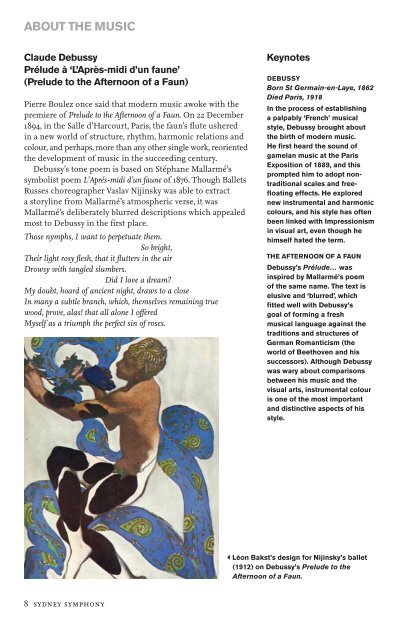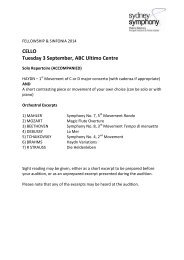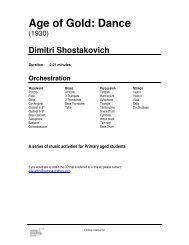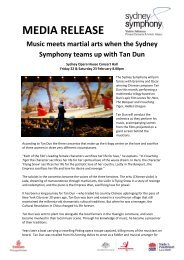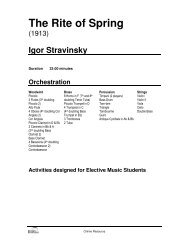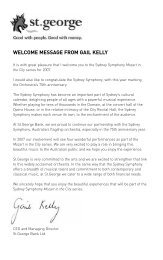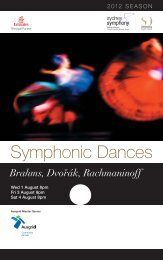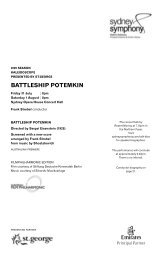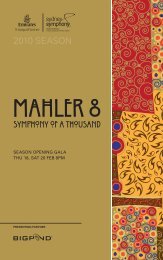Symphony for the Common Man - Sydney Symphony Orchestra
Symphony for the Common Man - Sydney Symphony Orchestra
Symphony for the Common Man - Sydney Symphony Orchestra
You also want an ePaper? Increase the reach of your titles
YUMPU automatically turns print PDFs into web optimized ePapers that Google loves.
ABOUT THE MUSIC<br />
Claude Debussy<br />
Prélude à ‘L’Après-midi d’un faune’<br />
(Prelude to <strong>the</strong> Afternoon of a Faun)<br />
Pierre Boulez once said that modern music awoke with <strong>the</strong><br />
premiere of Prelude to <strong>the</strong> Afternoon of a Faun. On 22 December<br />
1894, in <strong>the</strong> Salle d’Harcourt, Paris, <strong>the</strong> faun’s fl ute ushered<br />
in a new world of structure, rhythm, harmonic relations and<br />
colour, and perhaps, more than any o<strong>the</strong>r single work, reoriented<br />
<strong>the</strong> development of music in <strong>the</strong> succeeding century.<br />
Debussy’s tone poem is based on Stéphane Mallarmé’s<br />
symbolist poem L’Aprés-midi d’un faune of 1876. Though Ballets<br />
Russes choreographer Vaslav Nijinsky was able to extract<br />
a storyline from Mallarmé’s atmospheric verse, it was<br />
Mallarmé’s deliberately blurred descriptions which appealed<br />
most to Debussy in <strong>the</strong> fi rst place.<br />
Those nymphs, I want to perpetuate <strong>the</strong>m.<br />
So bright,<br />
Their light rosy fl esh, that it fl utters in <strong>the</strong> air<br />
Drowsy with tangled slumbers.<br />
Did I love a dream?<br />
My doubt, hoard of ancient night, draws to a close<br />
In many a subtle branch, which, <strong>the</strong>mselves remaining true<br />
wood, prove, alas! that all alone I off ered<br />
Myself as a triumph <strong>the</strong> perfect sin of roses.<br />
8 sydney symphony<br />
Keynotes<br />
DEBUSSY<br />
Born St Germain-en-Laye, 1862<br />
Died Paris, 1918<br />
In <strong>the</strong> process of establishing<br />
a palpably ‘French’ musical<br />
style, Debussy brought about<br />
<strong>the</strong> birth of modern music.<br />
He first heard <strong>the</strong> sound of<br />
gamelan music at <strong>the</strong> Paris<br />
Exposition of 1889, and this<br />
prompted him to adopt nontraditional<br />
scales and freefloating<br />
effects. He explored<br />
new instrumental and harmonic<br />
colours, and his style has often<br />
been linked with Impressionism<br />
in visual art, even though he<br />
himself hated <strong>the</strong> term.<br />
THE AFTERNOON OF A FAUN<br />
Debussy’s Prélude… was<br />
inspired by Mallarmé’s poem<br />
of <strong>the</strong> same name. The text is<br />
elusive and ‘blurred’, which<br />
fitted well with Debussy’s<br />
goal of <strong>for</strong>ming a fresh<br />
musical language against <strong>the</strong><br />
traditions and structures of<br />
German Romanticism (<strong>the</strong><br />
world of Beethoven and his<br />
successors). Although Debussy<br />
was wary about comparisons<br />
between his music and <strong>the</strong><br />
visual arts, instrumental colour<br />
is one of <strong>the</strong> most important<br />
and distinctive aspects of his<br />
style.<br />
Léon Bakst’s design <strong>for</strong> Nijinsky’s ballet<br />
(1912) on Debussy’s Prelude to <strong>the</strong><br />
Afternoon of a Faun.


